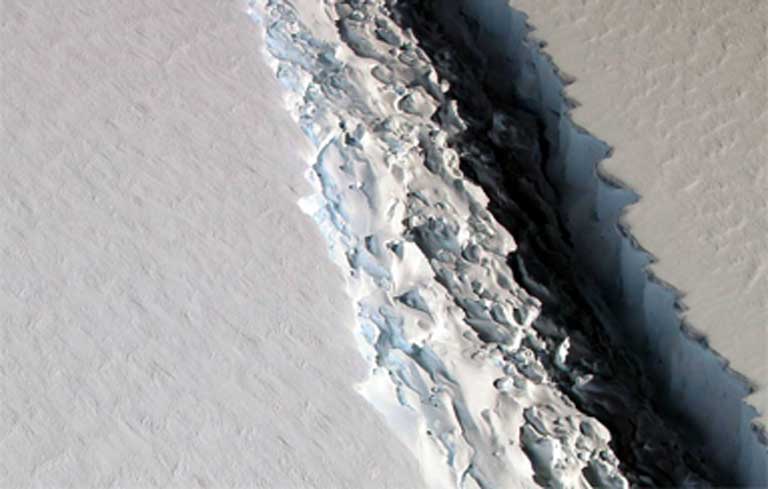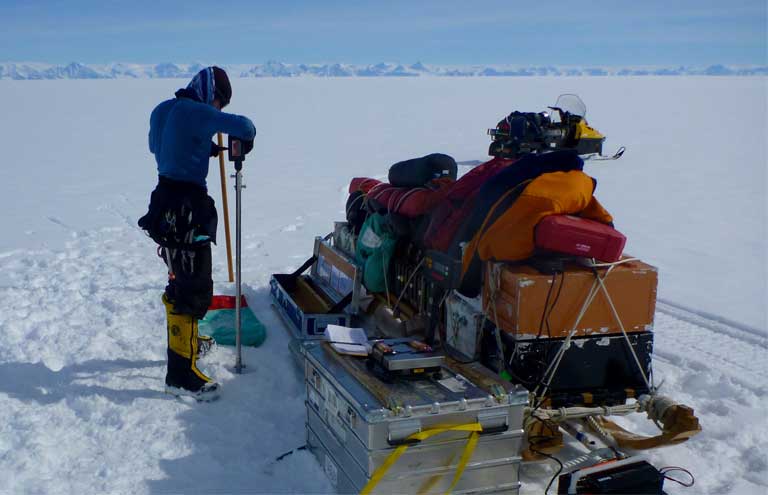- On Wednesday, a 5,800 square kilometer (2,239 square mile) section of Antarctica’s Larsen C Ice shelf, an area nearly the size of the U.S. state of Delaware, broke free and fell into the Southern Ocean.
- Scientists had been watching a lengthening and widening rift in the ice and expecting the separation since last December, though complex ice dynamics prevented them from knowing the exact day of separation.
- Researchers, including Dan McGrath, a geophysicist with the United States Geological Survey, have been watching the event with great interest.
- The resulting gigantic iceberg will not raise sea level, since the ice was already floating. However, researchers are concerned that the loss may weaken the remaining ice, leading to the collapse of the entire Larsen C Ice Shelf.

On Wednesday, all eyes were on Antarctica’s Larsen C Ice Shelf as a long-awaited one-trillion tonne iceberg, the size of the U.S. state of Delaware, was found to have finally broken loose, floating off into the Southern Ocean — and into the record books.
Scientists had been closely monitoring the ice shelf, the continent’s fourth largest, since last December, when they observed the then-90-mile long rift suddenly surge forward 11 miles.
Unable to put boots on the ground due to the ice shelf’s remote location, harsh weather and safety concerns, scientists relied on satellite imagery and the occasional fly-over to survey the rift in the months leading up to the calving. The lack of up-close surveillance, along with complex ice shelf dynamics, didn’t allow researchers to pinpoint the precise calving date, with Wednesday’s event very much expected, but coming as a bit of a surprise.

“It’s kind of like predicting earthquakes. There’s a lot of chaotic science,” says Dan McGrath, a geophysicist at the United States Geological Survey.
Though the break-off was ultimately sooner than anyone anticipated, scientists weren’t expecting the last stretch of the iceberg to hang on so long.
“We have been anticipating this event for months, and have been surprised how long it took for the rift to break through the final few kilometers of ice,” says Adrian Luckman, lead investigator of the Project MIDAS monitoring project.
Though few scientists have ever visited Larsen C, McGrath was lucky enough to spend three field seasons camped out on the ice shelf — in some cases, “really darn close” to the eventual rift — between 2009 and 2012.
Following the collapse of Larsen A and Larsen B in 1995 and 2002, respectively, McGrath decided to assess the stability of Larsen C in a warming climate for his PhD dissertation.

At this point, the calving event can’t be directly tied to climate change, he says. Between the 1950s and 2000s, the Antarctica Peninsula was one of the fastest warming locations on the planet. Lately, though, temperatures have been more variable, leading to an overall cooling in recent years, something that scientists can’t precisely explain.
For up to six weeks at a time, McGrath was stationed on the ice shelf, occupying a series of polar pyramids and dome tents. Temperatures hovered around −35 degrees Celsius (-31 Fahrenheit), with the warmest days reaching a balmy −5 degrees Celsius (23 Fahrenheit) during fieldwork.
When the weather was nice and the days were long, McGrath would power up his snow machine and travel tens of kilometers across the ice shelf to conduct radar surveys.


“We’d get up in the morning and go out, then come back to camp at 8 p.m., make a pot of espresso, grab some Snickers, and go back out again.” The skies never darkened past dusk. But in bad weather, McGrath would be unable to leave the tent for days at a time — and in one year, the entire field season was called off due to bad weather which prevented planes from getting over the infamous Drake Passage.
“When it’s nice, it’s a pretty spectacular place to be — you’re on this huge floating pancake of ice. But it’s a cloudy, stormy place, and those days are pretty few and far between.”
During his time on the ice, McGrath says the rift wasn’t a primary concern. “These rifts are common features of ice shelves,” he says. Many are visible in some of the earliest aerial photos of the region taken in the 1960s. Despite some warning signs, like significant surface melt and thinning ice, he and his colleagues ultimately believed the Larsen C shelf would be stable into the foreseeable future.

But now, with roughly 12 percent of the ice shelf broken off, scientists have changed their view, and believe the rest could go quickly. It’s possible that more rifts could form, leading to more calving. If this calving reaches the compressive arch — the equivalent of the keystone that supports an igloo — the whole shelf will collapse soon after. Following the break-off, we’re now roughly 15 to 45 miles from reaching that keystone.
With the sudden and rapid changes occurring on Larsen C, getting back to what remains of the ice shelf will be difficult, says McGrath. Prior to the iceberg’s calving, he had submitted two proposals to go down and study the rift by placing instruments into the ice to survey how much the rift had propagated. Unfortunately, funding didn’t come through in time, and all future work will likely be plagued and maybe prevented by safety concerns.
Thus far, the collaborative, UK-based Project Midas has provided the most secure vantage point. Project Midas first began monitoring the rift back in 2014 via satellite imagery, but this proved difficult. Skies over Larsen C are very cloudy, and months sometimes passed before satellites were able to pick up the advancing rift tip. Rather, researchers had to combine sequential pairs of advanced satellite images via interferometry to be able to see any changes at the tip of the rift.
On Wednesday, the final break-off was detected by NASA’s Aqua MODIS satellite instrument, which uses thermal infrared imaging, and later confirmed by NASA’s Suomi VIIRS radiometer instrument. The majority of monitoring over the last seven months, however, was done via the upgraded European Space Agency Sentinel-1 satellites which are able to penetrate through cloud cover and polar darkness. Research planes had already departed the region in preparation for the coming winter.
The record-breaking iceberg, twice the volume of Lake Erie, won’t contribute to sea level rise — ice shelves are already floating, much like ice cubes in a glass of water, meaning no seawater is displaced when an shelf breaks off. However, the calving could have consequences if it leads to the entire Larsen C ice shelf collapsing — then on-shore Antarctic glaciers could begin to flow more quickly to the sea, and raise ocean levels.
“Ice shelves are like the cork in the wine bottle,” explains McGrath. “They resist the flow of upstream glaciers. If you weaken or remove the ice shelf, those glaciers respond by flowing faster.”
In a blog post in January 2017, Project Midas wrote: “This event will fundamentally change landscape of the Antarctic Peninsula… The new configuration will be less stable than it was prior to the rift, and Larsen C may eventually follow the example of its neighbor Larsen B, which disintegrated in 2002 following a similar rift-induced calving event.”
For now, the immense iceberg will be closely monitored by scientists as it floats off into the ocean.
“The iceberg is one of the largest recorded and its future progress is difficult to predict,” says Luckman. “It may remain in one piece but is more likely to break into fragments. Some of the ice may remain in the area for decades, while parts of the iceberg may drift north into warmer waters.”
Correction: This article was updated to include more precise data plus quotes from the 12 July Project MIDAS press release.
FEEDBACK: Use this form to send a message to the author of this post. If you want to post a public comment, you can do that at the bottom of the page.

